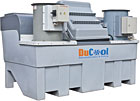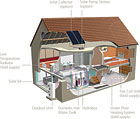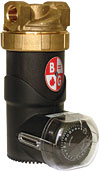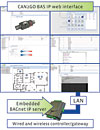
LAS VEGAS - The 10 winners of the 2011 AHR Expo Innovation Awards represent some of the most innovative new products in the HVACR industry, according to the panel of judges who evaluated them. The panel of judges was made up of American Society of Heating, Refrigerating, and Air-Conditioning Engineers (ASHRAE) members, who evaluated all submissions based on innovation, application, value to the user, and market impact.
There were a record number of entries this year, up 18 percent from the previous record. The nearly $13,000 generated by the entry fees will be donated to a charitable organization in the Las Vegas area. “We believe it is important to recognize manufacturers that have excelled in turning technology into useful and efficient products,” said Clay Stevens, president of International Exposition Co., which produces and manages the AHR Expo.
All 10 companies will be recognized at the awards ceremony at the AHR Expo, and one of the 10 category winners will be selected as the overall winner of the 2011 AHR Expo Product of the Year Award.

Building Automation
ecobee
www.ecobee.com
The ecobee Energy Management System (EMS) is designed for applications in which a simple programmable thermostat does not provide adequate control and a full-scale building automation system is too complex and cost prohibitive.
Through a dedicated management portal in the ecobee EMS, users can remotely monitor, identify, analyze, and troubleshoot performance issues. Because it is WiFi enabled, the temperature and operational settings can be managed from a central location, and action can be taken without having to send a technician on-site.
“The ecobee EMS provides superior performance with a straightforward, intuitive design and setup,” said Stuart Lombard, president and CEO. “It provides a cost-effective solution for a wide variety of commercial applications that will maximize any building’s efficiency, reduce energy consumption, and deliver significant cost savings.”
The ecobee EMS also delivers consistent and predictable installations resulting in less time on the job site, noted Lombard. It is a standard HVAC installation with no CAT 5 wires to run and no firewall rules to change. Once installed, the set-up is straightforward and efficient with an intuitive design, allowing users to manage an unlimited number of thermostats in multiple locations across diverse geographies. The configuration protocol allows for grouping of thermostats and multiple users with the flexibility to provide each user with varying degrees of accessibility and operating permissions.
The ecobee EMS was introduced in January 2010 and is widely available in every state and province in North America, as well as in Mexico and Australia.

Cooling
Advantix System
www.advantixsystems.com
The DuCool DuTreat System is a liquid desiccant air conditioner and dehumidifier that is designed to improve IAQ in commercial and industrial applications. Based on the principle of moisture absorption directly from air, the liquid desiccant technology enables optimal temperature and humidity levels without overcooling.
“Unlike all other dehumidification systems that either overcool to dewpoint or overheat to release moisture from a desiccant wheel, our product dehumidifies directly without wasting energy to reach required conditions,” said Trevor Wende, vice president of marketing. “As a result, this system cools and dehumidifies the air, resulting in a 30 to 80 percent energy savings.”
Other benefits of the system include simultaneous dehumidification and cooling, independent control of temperature and humidity, renewable power options (solar thermal, waste heat) for additional savings and/or LEED points, lower maintenance requirements than a conventional system, competitive price, and easy installation.
The DuCool DuTreat System is designed for commercial and industrial applications that experience very humid conditions and/or need to precisely control humidity levels for industrial processes. The system requires no expensive filters or other costly maintenance, and it can be installed as a simple retrofit.
Advantix introduced the system to the global market in 2010, and it is widely available in Europe, Asia, Canada, and the United States.

Green Building
Daikin AC (Americas) Inc.
www.daikinac.com
Altherma™ is a unique air-to-water heat pump system that heats, produces domestic hot water, and cools spaces. The system is designed to provide a high-efficiency, year-round solution for the new construction and retrofit residential market and is an ideal option for net zero homes.
The Altherma consists of two main components - an outdoor unit and a hydrobox - and can be combined with optional accessories such as a water tank and solar thermal kit. For space heating, the Altherma can be connected to low temperature radiators, underfloor heating, or fan coil units. The Altherma uses Daikin’s inverter variable-speed compressor technology, offering lower operation cost and higher efficiencies, even at low ambient conditions down to -4°F. The Altherma air-to-water heat pump delivers between 3 and 5 kWh of usable heat for every 1 kWh of electricity it uses and is three to five times more energy efficient than conventional fossil fuel systems.
While Altherma has energy efficiencies and additional features that can be compared to water-source heat pumps, it is easier to install because there is no need for expensive trenches or boreholes. The system features a single-phase power supply with a low starting current, allowing for integration to photovoltaic.
Altherma produces no direct CO2 emissions and offers numerous advantages over a traditional boiler system, said Marc Bellanger, marketing manager. “It offers a 30 to 50 percent reduction in CO2 emissions, it has low operation and maintenance costs, and it is very quiet.”
The Altherma has been available since June 2009.
Heating
LG Electronics USA Inc.
www.lghvac.com
The air-water heat pump (AWHP) with V2 Injection™ features a vapor injection technology that increases the heating capacity and the coefficient of performance (COP) by using a two-stage rotary compressor and phase separation. Typically, as the temperature decreases, the heat load of the building increases, causing the performance of other heat pumps to decline, and the difference has to be made up through heaters or fossil fuel consumption, said Samchul Ha, senior vice president, Air Conditioning and Energy Solution Research Lab.
“When the outdoor temperature falls, the AWHP keeps 100 percent of the heating capacity even at an outdoor temperature of -15°F with the V2 Injection technology,” said Ha. “We redesigned the Therma V, designed for the European market, by adding V2 Injection technology to its system. V2 Injection technology will be adapted and expanded to complement other systems, especially light commercial products, such as single cassette, applied PAC, and ducts for Korea.”
Ha noted that the base technology can be applied to cold climate heat pumps, especially those that use air and water as a heat source. Both residential and commercial products can use this technology depending upon compressor capacity, and AWHP can also be used as a replacement for gas boilers.
Usage, service, and installation are easy and provide the same benefits as the existing product, said Ha. “By applying V2 Injection technology, the high efficiency and high heating capacity product can provide benefits, such as saving electricity - the heating seasonal performance factor (HSPF) is 30 percent higher - and reducing the installation space.”
The AWHP was launched in December 2010 for the European market.

IAQ
Triatomic Environmental
www.freshaireuv.com
The APCO whole-house air purifier removes odors and microbial contaminants from the air using a unique absorptive photo-catalytic process. At the heart of the system is a Fresh-Aire UV light and a matrix of titanium dioxide infused carbon cells. The infused carbon cells attract and absorb airborne contaminates into the carbon matrix to remove them from the airstream. The UV light shining on the cells creates a photo-catalytic effect that reduces the captured VOC molecules until they are transformed into harmless water vapor and carbon dioxide. The cells are essentially regenerated on-site for ongoing treatment. In addition, the Fresh-Aire UV light has the added benefit of sterilizing microbial contaminates in the air and on the interior surfaces of the air system.
Every home with a central air system would benefit from APCO, said Christopher C. Willette, president. “Retrofitting into existing homes makes a noticeable reduction in cooking, pet, and smoking odors, and the UV light inside APCO reduces biological contaminants in the air and on the interior surfaces of the air system. The same benefits apply to new construction; in addition, it reduces toxic VOCs associated with construction materials like carpeting, wood composites, solvents, etc. Businesses such as hair salons, dog groomers, and medical offices will also benefit from the improvement in IAQ associated with APCO.”
The APCO unit is very easily installed in the duct- work of the central air system, noted Willette. An optional remote second UV lamp can be installed at the a/c coil to control mold growth at the coil. Servicing the APCO requires only replacement of the UV lamps every one or two years. The APCO cell never needs replacement as it is constantly being regenerated in place.
APCO first shipped in the summer of 2009 and is now widely available through major wholesale distributors.

Plumbing
ITT Residential and Commercial Water
www.bellgossett.com
The ecocirc® hot water circulator uses 68 percent less energy than most standard pumps and can save an average family of four more than 12,000 gallons of water a year by eliminating the need to wait for the water to get hot. Using only 10 watts of power, the equivalent of a small nightlight, the ecocirc can save a homeowner hundreds of dollars in energy costs a year, says the company.
Featuring the exclusive electronically commutated motor (ECM) technology and a patented spherical motor design, the ecocirc eliminates the need for a conventional shaft, seal, and bearing assembly. The rotor/impeller is the only moving part in the circulator, and it is magnetically balanced on a stationary ceramic bearing inside the pump housing to provide silent, long-lasting operation. In addition, it is seal-less, leak-free, and requires no maintenance.
“The ecocirc is affordable, has a smaller footprint, is lightweight (only 3 pounds), consumes less energy, and is easy to install,” said Marianne Szczech, circulator product manager. “Although these features offer advantages to contractors and specifiers, the real advantage is to the end user due to low operating cost.”
The ecocirc is primarily designed for the residential new construction market. It is resistant to scale build-up, ensuring optimal flow, and it also has a built-in temperature sensor that automatically adjusts frequency and voltage, as well as a built-in 24-hour timer. A solar model is also available.
The ecocirc became available in November 2009.

Refrigeration
Emerson Climate Technologies
www.emersonclimate.com
The Copeland Discus Digital™ compressor offers continuous and precise digital capacity modulation from 10 to 100 percent for enhanced compressor reliability and efficiency, longer food shelf life, and less food shrinkage, resulting in significant cost savings, said Jason Prenger, marketing manager for Food Retail and Industrial, Refrigeration Division. “As the newest addition to the Copeland Discus® compressor family, this product line offers unique capacity modulation and is available for the three-, four-, and six-cylinder Discus compressors.”
Supermarkets are ideal applications for Copeland Discus Digital compressors because the digital technology allows the system to specifically match the capacity being generated to the required load, says the company. This provides the opportunity for the system to operate more efficiently, resulting in optimum system performance and control. The capacity modulation also reduces the suction pressure and temperature variation of the refrigerated space and provides a dramatic decrease in compressor cycling rates, therefore improving compressor reliability. Copeland Discus Digital compressors ultimately help to decrease product loss, reduce the store’s energy consumption, and extend equipment life. Simple-to-apply field retrofit kits are available to upgrade a standard Copeland Discus compressor to a Copeland Discus Digital compressor.
According to Prenger, the Copeland Discus Digital compressor is beneficial to the commercial refrigeration sector because retailers need to reduce their energy footprint and avoid food spoilage. “With the cost of operating refrigeration equipment at 65 percent of total store electricity usage, reducing energy costs while preserving product integrity is a priority.”
The Copeland Discus Digital compressor was launched in 2009 and is widely available.

Software Award
CAN2GO
www.can2go.com
The CAN2GO embedded BAS IP web interface is a building management system (BMS) that requires no gateway, external server, or software. The IP web-based interface is hosted directly by CAN2GO controllers, each of which has several embedded servers, including a BACnet server, and all the necessary components (storage and RAM) to run a powerful building automation interface. Contractors only have to connect their network of CAN2GO controllers to the LAN to gain local or remote (via virtual private network) access to the interface using a web browser.
“The primary use of our controller hosted web interface is in small and medium commercial buildings, where it is used as a stand-alone BMS,” said Louis-Nicolas Hamer, PE, LEED AP, vice-president, product strategy. “In larger commercial buildings, the CAN2GO controllers and their web interface are used to integrate wireless technologies, such as EnOcean, into third party BACnet systems. In these cases, the CAN2GO embedded IP web interface is used to learn or discover wireless end-devices and convert them into BACnet objects - making them manageable from the third party front-end.”
With the CAN2GO embedded IP web interface, contractors and engineers can gain access to new markets - specifically, the untapped small and medium buildings’ market, said Hamer. While these represent 98 percent of buildings and 65 percent of floor space, they are seldom equipped with BMS because of high fixed costs. With CAN2GO, contractors can offer building automation with a lower price tag and shorter payback period - opening the doors to this market. “When it comes to setup, the CAN2GO solution has the simplest system architecture. No need to network gateways, install servers or software. Simply connect one CAN2GO controller to the LAN, and the interface is ready to go.”
CAN2GO controllers have been available since January 2010 and have been sold in North America, Europe, Asia, the Middle East, and Australia.

Tools And Instruments
Neutronics Inc.
www.refrigerantid.com
The Ultima ID Pro is a refrigerant analyzer used to determine the type and purity of refrigerant in an HVAC system, chiller, cylinder, or other device. The Ultima ID Pro connects to the system’s or cylinder’s high or low service port and takes a small sample of the refrigerant. It then uses infrared technology to determine the type and purity of the sample and displays it on the screen.
The Ultima ID Pro can be used in commercial and residential applications and is particularly useful for retrofit applications, said Peter Coll, refrigerant analysis product manager. “The recent restrictions on R-22 make recycling of refrigerant very important, and the introduction of numerous retrofit refrigerants makes determining the type and purity of the refrigerant in a system or cylinder impossible without an analyzer. Determining the type of refrigerant in a system prior to recovery allows the service technician to make sure the refrigerant is recovered into the correct cylinder to avoid cross contamination and expensive disposal costs.”
In addition to allowing contractors to recover the refrigerant correctly, the Ultima ID Pro ensures that the system is recharged with the correct refrigerant. The tool can also determine if a blend refrigerant has fractionated, causing poor cooling performance. The Ultima ID Pro works on a variety of refrigerants, including R-22, R-134a, R-404A, R-407C, R-410A, and hydrocarbons, and reduces the need for costly and time-consuming gas chromatography. The Ultima ID Pro delivers results in less than three minutes at an accuracy of ±2 percent or better, added Coll.
Ultima ID Pro was introduced in spring 2010 and is widely available through major distribution outlets worldwide.

Ventilation
Mitsubishi Electric
www.mehvac.com
The City Multi® VRF dedicated outside air system (DOAS) supplies outdoor ventilation air to a building independent of the HVAC air distribution or conditioning system. It accepts up to 100 percent outside air at temperatures ranging from -4°F to 109°F WB, preconditioning up to 1,200 cfm of air for introduction into downstream HVAC units.
“The City Multi VRF DOAS utilizes VRF inverter-driven technology to provide energy efficient outside air by utilizing the waste heat from cooling cycles to provide reheat capability without needing an additional or supplemental energy source,” said Joe Bush, City Multi application specialist. “No other split-type dedicated outside air system offers the installation flexibility and performance of the City Multi VRF DOAS. With line lengths of up to 623 feet one way, the application range is virtually limitless.”
While the City Multi VRF DOAS can be installed whenever 100 percent outside air processing is required, a typical installation would utilize the split system configuration in applications where a large package system is less feasible. Depending on the requirements of the supply air, a reheat system, which uses waste heat from the primary cooling coil to reheat and provide 45 percent rh air ranging from 63° to 83°, or a non-reheat system would be installed.
The indoor unit, which is less than 19 inches deep, would be installed in a ceiling or plenum space and connected on the intake side to an exterior louver. The supply air from the unit would be either ducted directly to the occupied space or provided to downstream indoor units to mix with the return air from the space.
The City Multi VRF DOAS was introduced in 2010 and is widely available.
Publication date: 01/17/2011


Report Abusive Comment